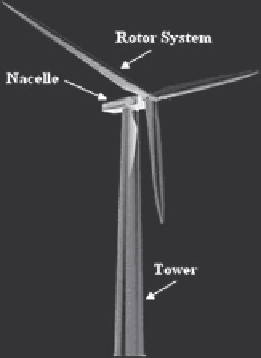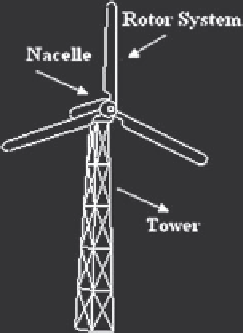Environmental Engineering Reference
In-Depth Information
(a)
(b)
Figure 1: (a) Free standing tubular wind turbine tower; (b) lattice wind turbine
tower.
turbine (HAWT) and support the mechanical and electrical system housed in the
nacelle. Wind speed increases with altitude and also tends to become less turbu-
lent. As a result more energy can be extracted with taller towers. However, this
comes at a price of higher cost of construction and installation. Choice of tower
height is based on a tradeoff between increased energy production at a particular
site and the increase in the cost of construction.
The principal types of towers currently in use are the free standing type using
steel tubes (Fig. 1a), lattice (or truss) towers (Fig. 1b) and concrete towers. For
smaller turbines, guyed towers are also used. Tower height is typically 1-1.5
times the rotor diameter. Tower selection is greatly infl uenced by the character-
istics of the site. The stiffness of the tower is a major factor in wind turbine
system dynamics because of the possibility of coupled vibrations between the
rotor and tower. In addition, there are several other factors which affect the selec-
tion of the type of tower and its design, such as the mode of erection and fabrica-
tion, sizes of crane required for construction, noise, impact on avian population
and aesthetics. Among the different type of towers, tubular towers are more com-
mon and they are also preferable due to aesthetics and in minimizing impact on
avian population.
One of the primary considerations in the tower design is the overall tower stiff-
ness, which in turn affects its natural frequency. From a structural dynamics point
of view, a stiff tower whose fundamental natural frequency is higher than that of
the blade passing frequency (rotor's rotational speed times the number of blades)
is preferable. This type of tower has the advantage of being relatively unaffected
by the motions of the rotor-turbine itself. However, the cost may be prohibitive due
to a larger mass and hence more material requirement.


Search WWH ::

Custom Search